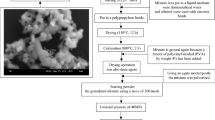Abstract
This work presents a study of the influence of both Bi content and Sb/Bi ratio on the electrical characteristics of a commercial-type ZnO varistor. In contrast to previous studies two nonlinear coefficients, the breakdown fields and energy absorption abilities were measured after sintering at 970°C or 930°C. The Bi-content was varied from 0.9 to 1.8 at% while the Sb/Bi ratio was varied from 0.8 to 1.5, leading to values of up to 104 for the nonlinear coefficient α1, 1100 V mm−1 for the breakdown field and 1137 J cm−3 for the energy absorption ability. The highest α value was measured for the highest Bi-content and the lowest Sb/Bi ratio and vice versa. The breakdown field E V increased with lower sintering temperature, increased Sb/Bi ratio (at a given Bi-content) and increased Bi-content (at a given Sb/Bi ratio). The energy absorption coefficient increased at the higher sinter temperature and with lower Sb and Bi concentrations.
The observed effects were related to the amount of spinel phase (Zn7Sb2O12) formed during the sintering process and the amount of liquid phase present during early stages of the sintering process.
Similar content being viewed by others
References
M. Matsuoka, Jpn. J. Appl. Phys., 10, 736 (1971).
M. Bartkowiak, M.G. Comber, and G.D. Mahan, J. Appl. Phys., 79, 8629 (1996).
S. Ezhilvalavan and T.R.N. Kutty, J. Mater. Sci., 7, 137 (1996).
J. Fan and F.R. Sale, in Electroceramics: Production, Properties and Microstructures, edited by W.E. Lee and A. Bell (Ashgate Publishing Company, London, 1994), p. 151.
J. Fan and R. Freer, J. Mater. Sci., 32, 415 (1997).
T.K. Gupta, J. Mater. Res., 7, 3280 (1992).
M.C.S. Nobrega and W.A. Mannheimer, J. Am. Ceram. Soc., 79, 1504 (1996).
G.M. Safronov, V.N. Batog, T.V. Stepanyuk, and P. Fedorov, Russ. J. Inorg. Chem., 16, 460 (1971).
E. Olsson and G.L. Dunlop, J. Appl. Phys., 66, 3666 (1989).
E. Olsson, L.K. Falk, and G.L. Dunlop, J. Mater. Sci., 20, 4091 (1985).
H. Wang and Y.-M. Chiang, J. Am. Ceram. Soc., 81, 89 (1998).
E. Olsson, G. Dunlop, and R. Österlund, J. Am. Ceram. Soc., 76, 65 (1993).
D. Dey and R.C. Bradt, J. Am. Ceram. Soc., 75, 2529 (1992).
J. Kim, T. Kimura, and T. Yamaguchi, J. Am. Ceram. Soc., 72, 1541 (1989).
T. Asokan, G.N.K. Iyengar, and G.R. Nagabhushana, J. Mater. Sci., 22, 2229 (1987).
M. Inada and M. Matsuoka, Jpn. J. Appl. Phys., 19, 409 (1980).
J.L. Huang and K.B. Li, J. Mater. Res., 9, 1526 (1994).
O. Alvarez-Fregoso, Rev. Mex. Fisica, 40, 771 (1994).
M. Ito, M. Tanahashi, M. Uehara, and A. Iga, Jpn. J. Appl. Phys., 36, 1460 (1997).
A. Mergen and W.E. Lee, J. Europ. Ceram. Soc., 17, 1049 (1997).
A. Lorenz, J. Ott, M. Harrer, E.A. Preissner, A.H. Whitehead, and M. Schreiber, J. Electroceram. Soc., 6, 43 (2001).
T.K. Gupta, J. Am. Ceram. Soc., 73, 1817 (1990).
L.M. Levinson and H.R. Philipp, Ceram. Bull., 65, 639 (1986).
W.G. Morris, J. Vac. Sci. Technol., 13, 926 (1976).
R. Einzinger, Appl. Surf. Sci., 1, 329 (1978).
E.R. Leite, M.A.L. Nobre, E. Longo, and J.A. Varela, J. Mater. Sci., 31, 5391 (1996).
V. Kraševec, M. Trontelj, and L. Golič, J. Am. Ceram. Soc., 74, 760 (1991).
M. Inada, Jap. J. Appl. Phys., 17, 1 (1978).
H. Honning and E.J. Kohlmeyer, Erzbergerbau Metallüettenw., 10, 12 (1957).
Y.S. Lee and T.Y. Tseng, J. Mater. Sci.: Materials in Electronics, 8, 115 (1997).
F. Greuter, T. Christen, and J. Glatz-Reichenbach, Mat. Res. Soc. Symp. Proc., 500, 235 (1998).
A. Vojta and D.R. Clarke, J. Appl. Phys., 81, 985 (1997).
M. Bartkowiak and G.D. Mahan, Phys. Rev. B, 51, 10825 (1995).
Author information
Authors and Affiliations
Rights and permissions
About this article
Cite this article
Ott, J., Lorenz, A., Harrer, M. et al. The Influence of Bi2O3 and Sb2O3 on the Electrical Properties of ZnO-Based Varistors. Journal of Electroceramics 6, 135–146 (2001). https://doi.org/10.1023/A:1011408818555
Issue Date:
DOI: https://doi.org/10.1023/A:1011408818555




